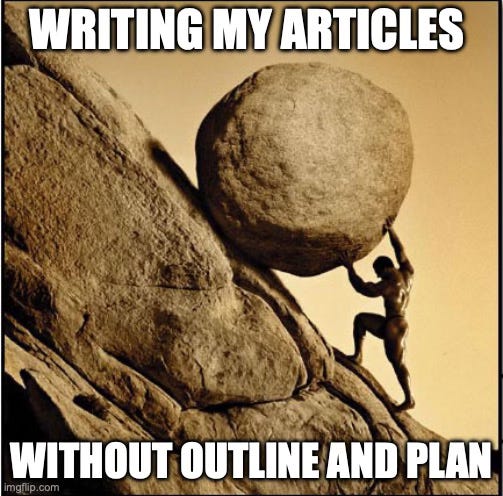The Secret Weapon of Prolific Writers: Ditch These 4 Habits and Watch Your Writing Soar
By using these shortcuts, you can produce more content in less time at a higher level.
If you’re new to writing or looking into improving this skill, you’ll listen to many who explain what to do. I’ll try to tell you what not to do based on my mistakes and experiences.
No matter my current occupation, when you ask me who I am. I’d say I am a writer.
I have been a writer since I could hold a pen and scribble my first words in my school notebook.
I’ve always known writing is something more for me. My pathway just confirmed my gut — feeling:
I was just not writing for living, I was living for writing.
I got a BA in Journalism and then worked as a journalist for 12 years.
But, when I switched to blogging and writing for marketing, I realised how bad my writing process was.
As a journalist, my writing was always triggered by tight deadlines and editors' ideas.
Article by article, I faced an endless grind of new topics, new people, and new content that I had to start every time from scratch.
As a marketer, I had to devise a system and process so I would not write the same things over and over on the blank page.
I needed to capture SOP (standard operating procedure) for myself.
So what did I do?
I removed these things from my writing process, making it faster, less stressful, and more sustainable.
P.S. Just a word of warning: even though I have all these things in place, sometimes I’m a hot mess. I don’t have ideas, and I'm struggling to write, starting over and over.
The best thing I can do in these moments is to go back to these basics and unstuck myself.
Ad hoc ideation
Picture this: you need to write an article. You stare at the screen, and the more you think about the topic, the bigger “tabula rasa” your brain becomes.
Or this: every time you have an idea, you write it down. Then, when you need to write, open your idea hub, pick one and start writing.
It’s like cooking. If you need to come up with an idea of what to cook every time before you start cooking, you’ll get tired of it in a few days.
But if you plan your meals ahead and shop for all the ingredients, you only need to follow the recipe.
Use your idea hub. (I can help you make your own).
Utilise creative moments or that tiny window of time just before you go to sleep (yes, I have a notebook on my nightstand). Then, writing will become less stressful and demanding because your have your best ideas written on the paper.

Starting with white paper every time
Ideas are usually not enough.
You need structure.
Outlines are the perfect way to give your writing a foundation. Then, building an article on it is a piece of cake (most of the time).
How to write a good outline?
There are many ways, this is mine:
Think about it as a list of H2s.
What are the main points of your writing?
What is the know and feel of your article?
What information your audience will know after your article?
What is the emotion you want to induce?
How to make an outline template?
To speed up your writing process, you can use templates, aka structure. It’s the best thing to beat writer’s block.
You can use many of the templates available on the Internet
You can follow this simple pathway:
Intro
Hook
Short introduction
Present the problem and outlook that the reader can expect
p.s. try to establish your expertise and POV between the intro and body
Body
It should reply to most of the answers the reader may have about the topic:
What information do you want to share
What emotion do you want to induce
What readers can take as a valuable takeaway from your article
You can separate the body into a few sections—paragraphs or apps—and each should have a small intro explaining why it matters, your thesis, and research or an example to support it.
Conclusion
Summarise your points
Include CTA.
You don’t have to use them. Sometimes you’ll sit and pour your soul over the paper. You don’t need equipment to peel words from you.
But, sometimes… oh, it is Sysiphus job.
Source: https://imgflip.com/memegenerator/90886675/Sisyphus
Templatize yourself!
The best way to use templates and stay authentic is to templatize yourself!
Use your best work — the article that have a proven record and fans.
Analyse it and make a template out of it.
These tips will help you avoid the next mistake: spending hours editing articles to make them perfect.
Spending too much time on editing
The unwritten rule of writing is — never write and edit in one attempt.
Write the first messy draft.
Then wait.
Sleep on it if you can.
Write when you’re emotional. When words are dancing and you’re the artist.
Edit when you feel ruthless and in the mood for a serious cut.
Let me tell you — you won't get that perfect article. That doesn’t exist.
Read this quote from Ernest Hemingway:
“I rewrote A Farewell to Arms at least fifty times. You’ve got to work it over. The first draft of anything is shit. You just get hard work and the better you write the harder it is because every story has to be better than the last one. It’s the hardest work there is.
The only thing I can advise you is to keep on writing but it’s a damned tough racket. The only reason I make any money at it is I’m a sort of literary pirate. Out of every ten stories I write, only one is any good and I throw the other nine away.”
Good editing is a serious skill. Good editing is damn hard writing.
Editing is essential, but you should probably spend the most time perfecting your headline. In the world of moving feeds and cheap fun, you have less then second to get someone’s attention.
So, don’t:
Confusing readers with bad headlines
Bad headlines are like an ugly shop window — no one would want to come into store if the entrance doesn’t look promising.
Think about the headline as a promise to your reader. You need to reveal:
What exactly is inside
What problem is solving
How will that help them? (They aren't interested in you, you know?)
There are many ways to make your headlines better.
Here are two quick checklists to help you while you are making them magnets for your excellent reading inside:
4 U’s
The 4 U’s is developed by copywriting Michael Masterson and stands for:
Useful: how does the headline help the reader
Urgent: What urgency will move the reader to read the article
Unique: What is the surprise element
Ultra Specific: What details make it really specific
You can also try to utilise the 4P method from sales page copywriting (squeezing all aspects in one headline requires a bit of mastery)
Pain: The reader’s pain point
Product: The product
Promise: The big promise of the product.
Possibility: The possibility of a better future with the product.
Example:
Break Procrastination Circle: 6 Writing Tools that Will Help You Write 67% Faster.
Don’t be afraid to experiment.
Practice, practice, practice: Even Hubspot or CoSchedule make almost 30 alterations to their headline until they find the one that works best.
What’s next?
Religiously write and collect your ideas.
Organise them into an idea hub.
Use proven outlines.
Edit ruthlessly but with a delay.
Perfect your headlines.
By using these shortcuts, you’ll be able to produce more content in less time at a higher level.
No matter what type of content you need, you can apply the same principle and speed up your writing.
Love ya,
Angelina.






Very good tips.
I love your headlines, Angelina! You have a way of igniting curiosity and interest in a just a few words.